- Latest Reviews
- Culture
- Live reviews
- Sydney live reviews
Two actors take on the multiverse in jaw-dropping new production
By John Shand and Peter McCallum
THEATRE
Constellations ★★★★
Wharf 1 Theatre, until September 2
Your jaw drops before a word is said. Hanging from the flies is an otherworldly, golden, doughnut-shaped ceiling that could be made of sea sponge or brain matter. It looms low over the stage, with a pristine white dome at its centre and light traversing its perimeter in a way that suggests space travel.
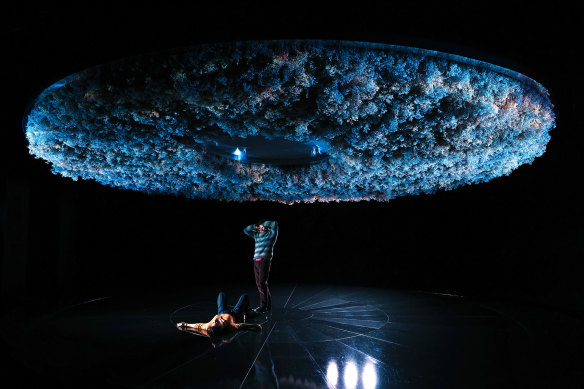
Isabel Hudson’s design for Constellations is jaw-dropping.Credit: Prudence Upton
Nick’s Payne’s 2012 play specifies no setting, so this astonishing creation has burst from the imaginations of designer Isabel Hudson and director Ian Michael. It sets us up for a mind-expanding night in the theatre, in which Payne embraces the concept of the multiverse, whereby every atom, being, event and experience may exist in multiple universes. It does not matter whether this is concurrent or sequential because time is no longer a continuum.
Into this set of possibilities Payne inserts two characters: Marianne (Catherine Van-Davies), a physicist specialising in theoretical early universe cosmology, and Roland (Johnny Carr), a beekeeper. He then runs a science experiment on their relationship, offering variations on their meeting, dating, moving in together, breaking up, reconnecting, reconciling and dealing with Marianne’s brain cancer diagnosis.
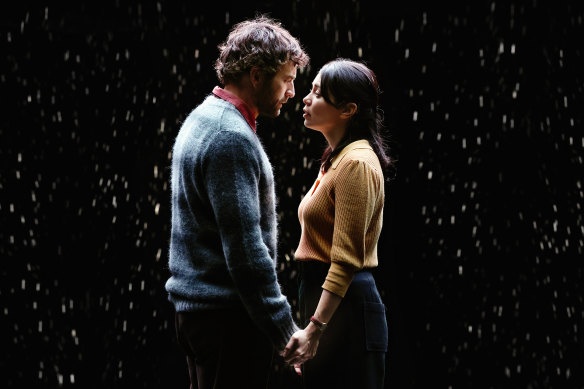
Catherine Van-Davies and Johnny Carr give stellar performances.Credit: Prudence Upton
These events are like shards of a broken window that are picked up and scrutinised from different angles in different light, while still constituting a window. Scenes are repeated two, three or even four times, with Michael constantly having to decide how to relocate the actors on the round raked stage to indicate a fresh take on the same event. Often that fresh take includes a new variant, just as minimalist music evolves with tiny incremental changes.
If that all sounds like an exercise in abstraction, in fact, it’s the opposite. The characters are engaging, funny and moving. Their lines must be fiendishly difficult to deliver in the right order, and so clear direction is as vital for the actors as for the audience. Michael certainly provides that, and is rewarded with stellar performances. Van-Davies breaks our hearts when brain cancer affects her ability to speak, and Carr’s rustic tries so desperately to do right, often without understanding what that entails.
Benjamin Brockman’s lighting and James Brown’s music are complicit in removing us from reality and burying us in it in the same breath. It’s all over in 70 minutes, but it’s probably happening somewhere else simultaneously. Or not.
Reviewed by John Shand
OPERA
Mad Scenes with Jessica Pratt ★★★★
Opera House Concert Hall, August 3
With haunting warmth in slow, searching passages and fleeting nimbleness in moments of growing delirium, soprano Jessica Pratt spanned the spectrum of Italian operatic derangement, from somnambulistic bewilderment to cut-snake madness.
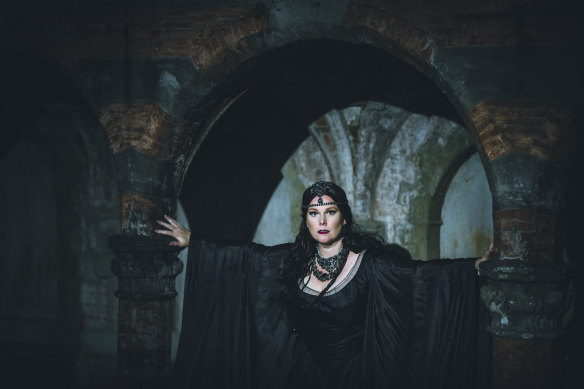
Jessica Pratt is one of the world’s foremost sopranos.Credit: Marco Borrelli
In the operas of Bellini and Donizetti, mental instability in heroines paradoxically unleashed new powers, the voice taking flight as though unfettered from the burdens of conventional rationality.
As with Ophelia in Hamlet, insanity is the tragic climax, where the true soul is laid bare, fiery and vulnerable. Hearing five of opera’s “good bits” in a row risks turning these climactic moments into vacuous vehicles of deracinated display.
Yet, in this case, the carefully chosen selection revealed variety and balance, exploring different aspects of “bel canto” singing and Pratt’s art.
In the climactic aria of Bellini’s La Sonnambula, Pratt nurtured quiet notes in the recitativo section, colouring them with distinctive pastel tones. In Donizetti’s relatively unknown Emilia di Liverpool (yes, it does sound like a spoof title), Pratt brought out rewarding golden qualities in her mid-register.
Pratt used the space of the hall to telling effect, projecting her voice to different corners, and at key moments rotating as she opened out the sound to magnify the echo’s delicate after-effect.
She finished the first half, bloodstained but unbowed, with opera’s most famous mad scene from Donizetti’s Lucia di Lammermoor. Here she teased out layers of tonal variety with pellucid clarity. Flautist Lisa Osmialowski followed her distracted outburst with subtle, understated precision, supporting and colouring from behind like a wispy spectre.
To begin the second half, violinist Patrick Savage played the solo part in the Prelude to the Act III Finale of Verdi’s I Lombardi with a delicately glowing tone of warm silkiness.
Released from the opera pit, their usual abode, into the relative sunlight of the Concert Hall’s newly refurbished acoustic, the Opera Australia Orchestra shone in a series of orchestral numbers under conductor Johannes Fritzsch. There was textured depth to the trombone choir that opened Verdi’s Nabucco Overture, luxuriant string sound in the Intermezzo for Mascagni’s Cavalleria Rusticana. And in the Ballet Music from Verdi’s Macbeth, Fritzsch brought incisive rhythmic vigour.
Pratt enhanced the resonance at the start of Bellini’s I Puritani by singing from a side entrance hall. Entering through the auditorium, she nurtured quiet covered tone on soft high notes before a closing section of deftly light agility to deliver one of the evening’s highlights.
Impressively, she began the scene from Donizetti’s Linda di Chamounix unaccompanied, the orchestra confirming the accuracy of her pitch when it subsequently joined.
The performance was courageous, and occasionally a high note found the wrong rung at the height of the ladder, but when she returned to the same note or higher flawlessly it was clear this was a hazard of performance not due to any shortcoming of control.
The encore, Bernstein’s Glitter and be Gay, unleashed a different sort of madness, and it was clear from the audience’s standing ovation that they would have gladly stayed all night given the chance.
Reviewed by Peter McCallum
THEATRE
Mr Bailey’s Minder ★★★½
Ensemble Theatre, until September 2
John Gaden makes his entry down the stairs of the dilapidated house owned by his character, the elderly Leo Bailey, oozing poison from every pore.
It’s now 20 years since playwright Debra Oswald created in Leo a character we like, despite all he says, does and has done. Gaden brings great warmth to the role, maximising the humour, pathos and extraordinary rapture of Leo when he sees, for the first time in decades, his favourite of the many pictures he’s painted.
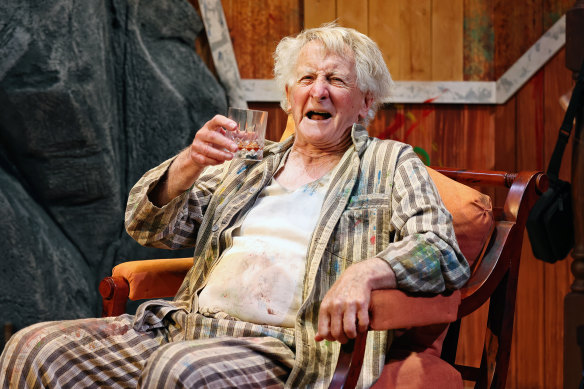
John Gaden captures all the ugliness and the shame beneath Leo Bailey.Credit: Prudence Upton
Leo is one of Australia’s most acclaimed artists, bathing his subjects in luminosity and himself in his fame. He has, however, been decidedly less gifted as a husband, father and friend.
So, when Margo (Rachel Gordon), the only one of his children who will still speak to him, hires a new live-in carer, Therese (Claudia Ware), expectations of a long tenure are modest. But Leo and Therese share a strong bond: shame about their pasts.
The play demands a burgeoning chemistry between the pugnacious Therese and the self-pitying, malevolent, alcoholic Leo, and in Damien Ryan’s production Ware and Gaden achieve that, as their characters learn to let down their guards.
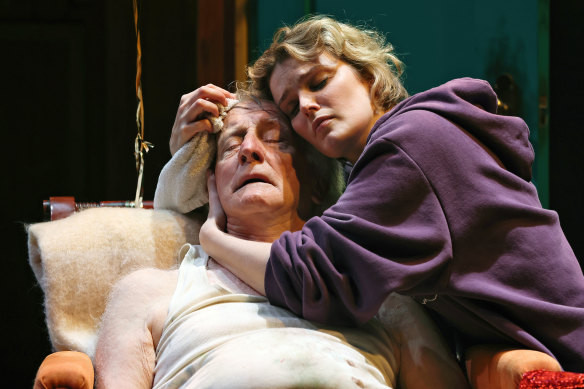
The chemistry between Gaden and Ware is at the heart of this production.Credit: Prudence Upton
Yet, as good as they are, the ultimate quality of their performances is inhibited by the play’s inherent flaws. The spanners Oswald throws in the workings of the plot feel structurally predictable, and the turning points are too pat, as when Leo instantly agrees to give up booze on the promise of Therese taking him on outings, or when Margo suddenly turns on Therese. There are also word choices and lines that are incongruous for the characters.
The role of Margo is a tricky one to nail, and Gordon initially struggles to blend the requisite primness with resentment, without becoming too arch.
The fourth actor, Albert Mwangi, is more consistent, albeit in the easier roles of, first, the despicable Gavin and, then, Karl, the improbably obliging handyman who can see the good in Leo and is more than a little keen on Therese.
While it’s a play in which more dots could be left for us to connect ourselves, it’s also more than worthy of this revival because it plumbs considerable depths in the relationship between artistry and humanity, and between baseness and forgiveness.
Reviewed by John Shand
Find out the next TV, streaming series and movies to add to your must-sees. Get The Watchlist delivered every Thursday.